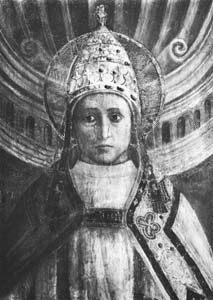Pope Zephyrinus
| Saint Zephyrinus | |
|---|---|

| |
| Birth name | Zephyrinus |
| Papacy began | 199 |
| Papacy ended | December 20, 217 |
| Predecessor | Victor I |
| Successor | Callixtus I |
| Born | ??? Rome, Italy |
| Died | December 20 217 Rome, Italy |
| Styles of Pope Zephyrinus | |

| |
| Reference style | His Holiness |
| Spoken style | Your Holiness |
| Religious style | Holy Father |
| Posthumous style | Saint |
Pope Saint Zephyrinus was pope from 199 to 217.
He was a Roman who had ruled as head bishop for close to 20 years, and was elected to the Papacy upon the death of the previous pope, Victor. Zephyrinus was succeeded, upon his death on December 20, 217, by his principal advisor, Callixtus.
Papacy
Decrees
Zephyrinus decreed that sinners who had been excommunicated could be received back into the Church after completing a penance prescribed by Church officials.
He also decreed that the Holy Communion only be received by those 14 and older, a rule which remained unchanged until Pope Pius X lowered it to seven years of age, which he had called "the age of reason."
Conflicts
Under the papal rule of Zephyrinus, the persecution of Christians by the Roman government markedly worsened. Some of this is tied to the fact that three years into his rule, the Roman Emperor Septimius Severus held a celebration to mark his tenth anniversary as emperor. Christians did not attend the event. Later in the year, Septimus Severus issued an edict which forbade conversion to Christianity under the severest penalties. This was part of an effort by Septimus to create a single Roman religion.
A second major incident during the rule of Zephyrinus led to the first major division of the Church. The Monarchianism movement, a movement which had been declared heretical by the Church, was growing rapidly. Zephyrinus did little in response to this. He denounced the Monarchaists on the advice of Callixtus, but took no other action. The renowned theologian Hippolytus heavily criticised him, accusing him of favouring the Christological heresies of the Monarchians, and of subverting the discipline of the Church by receiving sinners back into the Church who had been found guilty of grave sins. He also claimed that Zephyrinus was too heavily influenced by his advisor. Hippolytus wanted the pope to issue a decree which condemned the heretical beliefs of the Monarchians and Patripassians and created distinct dogma which represented the Person of Christ as actually different from that of the Father. [1] Upon the death of the pope, and the election of Callixtus, Hippolytus and a number of his scholars left the Church, and the Church entered into its first division. For over ten years Hippolytus stood at the head of a separate congregation, possibly as bishop, and is sometimes considered the first Antipope.
Antipope Natalius[1], bishop of a rival sect of Christianity in Rome, supposedly tearfully submitted himself to Pope Zephyrinus, covered in ash and dressed in sackcloth, after being "scourged all night by the holy angels."
The feast of Pope Zephyrinus, which was formerly held on 26 August,[2] is now celebrated on 20 December, the day of his death.[3]
ReferencesISBN links support NWE through referral fees
- ↑ CATHOLIC ENCYCLOPEDIA: Pope St. Zephyrinus
- ↑ Calendarium Romanum (Libreria Editrice Vaticana, 1969), p. 136
- ↑ Martyrologium Romanum (Libreria Editrice Vaticana, 2001 ISBN 88-209-7210-7)
| Saints Portal |
Books
- Rendina, Claudio, The Popes Histories and Secrets (2002)
| Roman Catholic Popes | ||
|---|---|---|
| Preceded by: Victor I |
Bishop of Rome Pope 199–217 |
Succeeded by: Callixtus I |
| ||||||||||||||||
Credits
New World Encyclopedia writers and editors rewrote and completed the Wikipedia article in accordance with New World Encyclopedia standards. This article abides by terms of the Creative Commons CC-by-sa 3.0 License (CC-by-sa), which may be used and disseminated with proper attribution. Credit is due under the terms of this license that can reference both the New World Encyclopedia contributors and the selfless volunteer contributors of the Wikimedia Foundation. To cite this article click here for a list of acceptable citing formats.The history of earlier contributions by wikipedians is accessible to researchers here:
The history of this article since it was imported to New World Encyclopedia:
Note: Some restrictions may apply to use of individual images which are separately licensed.
